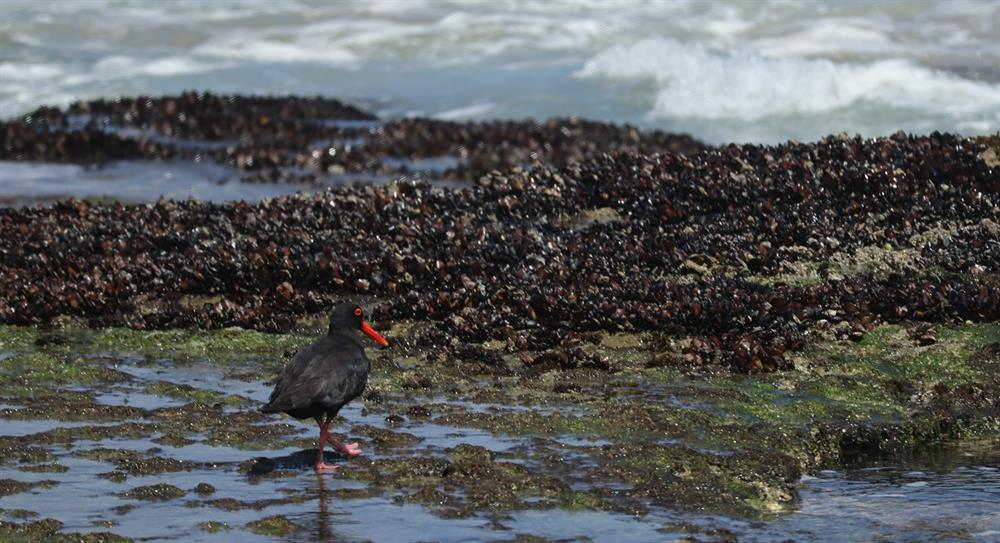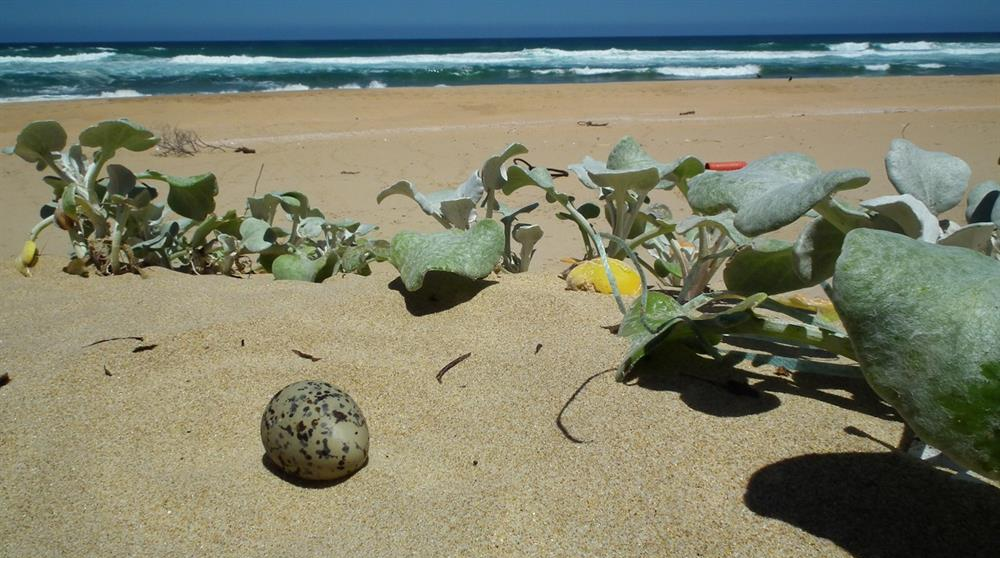KNYSNA NEWS - African Black Oyster-catchers, Heamatopus moquini, are a species that is endemic to the shoreline of southern Africa, extending from Port Edward on the east coast of South Africa up the west coast of Namibia to the Hoanib River mouth.
They forage in the intertidal zone, most active at low tide, targeting Brown Mussels (Perna perna), Mediterranean Mussels (Mytilidae galloprovincialis), Sand Mussels (Donax serra), Limpets, polychaetes and crustaceans. Occasionally they will scavenge washed up Red Bait (Pyura spp).
Living up to 29 years, the onset of first breeding occurs between 3 and 7 years.
Breeding is seasonal, with pairs initiating the establishment of breeding territories in October and laying 1 or two eggs between mid-November and early December with an incubation of approximately 30 days.
African Black Oystercatchers' nests are often a simple scrape in the sand above the high water mark.
While their mottled colouration provides some thermal regulation through Brownian motion in the egg white when not incubated by an adult, they will overheat and die if left exposed to the summer sun for too long.
 The horizontal intertidal shelf provides a large surface area of mussel beds for oystercatchers to forage from.
The horizontal intertidal shelf provides a large surface area of mussel beds for oystercatchers to forage from.
Off-road vehicle ban
In the mid to late 1990s the conservation status of African Black Oystercatchers was near threatened and considered the second most threatened avian species in South Africa, due to their low recruitment rate and susceptibility to human disturbance, particularly during breeding season.
It was their susceptibility to human disturbance which motivated the banning of off-road vehicles on beaches by the then SA Minister of Environmental Affairs and Tourism on the 21 December 2001.
In the Garden Route, within 10 years, an increase of 40% was recorded, in most part attributed to the exclusion of ORV on beaches.
Strandloper Project
The four Strandloper Project Coastal Research Expeditions have valuable information on the density and distribution of African Black Oystercatchers in the Southern Cape.
In 2019 the Strandloper Project initiated a series of coastal research expeditions, hiking between 200km and 250km per year over a period of 10 to 12 days.
The primary objective of the expedition was to document the distribution and density of plastic pollution and fishing gear debris along the shoreline, and to date the expedition team has hiked 960km of the coastline between Hermanus and Cape Recife.
The annual expeditions did however offer an ideal opportunity to survey indicator faunal species, and in 2020, African Black Oystercatchers were recorded.
Cybertracker
Using Cybertracker, geo-referenced records of oystercatchers were made, including numbers of at a location, activity, and age.
As expeditions are conducted in May or October, most of the population recorded are adults.
During the four expeditions between 2020 and 2023, a total of 769 records were made for a total of 1801 oystercatchers.
In addition, whenever a section of coastline is visited or hiked, observations of oystercatchers are recorded and combined for analysis of oystercatcher population density and distribution.
Intertidal influences
Reviewing our data, what stands out is that the type of shoreline has a direct influence on regional densities of oystercatchers, underpinned by target prey species distribution, with sand shores supporting lower diversity and densities of prey species compared to rocky intertidal shelves where territorial ranges vary from 1 breeding pair per 2000m on sandy shores and 200m/breeding pair on flat intertidal shelves.
Within these two types of shorelines, there are noticeable variations in the densities, ranging between 1 pair/2000m and 1 pair/280m on sandy shores and 1 pair/200m and 1 pair/1.25km on rocky shores.
On sandy shores, the average density of 1 pair/2000m holds true except for one section between the Gamtoos River and Van Stadens River mouth, where 45 observations of 124 oystercatchers indicate the density was an impressive 280m/pair.
 Folk out on a sightseeing trip. On all the sandy beach sections where we recorded vehicles driving, or saw tyre tracks, there were no observations of oystercatchers.
Folk out on a sightseeing trip. On all the sandy beach sections where we recorded vehicles driving, or saw tyre tracks, there were no observations of oystercatchers.
It would appear that this section of shoreline has a high density of Sand Mussels, as witnessed by telltale "butterflied" shells, to support the population of oystercatchers along this stretch.
Fossil records of predominantly Sand Mussels in middens in the dunes along this sandy shoreline indicate that the high density of this prey species has been historically stable.
Beachgoers
The impact of beachgoers on oyster-catchers is highlighted by the absence of records in close proximity to public access parking areas.
Variations in oystercatcher density on sand shores is observable at a number of locations, both of which suggest that human activities are the root cause.
In the Garden Route, densities within a 1000m of a public access parking area are exceptionally low, with most areas within this 1000m zone having zero oystercatchers.
The sandy beach sections with blank patches are where there was evidence of frequent vehicles on the beach; most of it could be attributed to abalone poaching activities, but not exclusively, as we documented many joy trippers cruising by on sightseeing drives or out fishing along these sections.
Tyre tracks
On all the sandy beach sections that we recorded vehicles driving, or saw tyre tracks, there were no observations of oystercatchers.
Between Struisbaai and Hermanus, three sandy beach sections had zero oystercatchers, all of which had evidence of vehicle tracks indictive of regular driving activity along these sections of coastline.
 Oystercatchers' nests are often a simple scrape in the sand above the high water mark. Photos: Mark Dixon, the founder and CEO of the Strandloper Project.
Oystercatchers' nests are often a simple scrape in the sand above the high water mark. Photos: Mark Dixon, the founder and CEO of the Strandloper Project.
It is important to note that this section of the coastline experiences high poaching pressure for abalone, particularly Haliotis midae, and that poachers regularly drive on beaches, though a number of "tourists" and fishermen were observed driving on these beaches.
Another activity that had an affect on population density on sandy and mixed substrate shorelines was collection and processing by kelp (Eklonia maxima) harvesters.
Kelp harvesting and processing operations along sections of mixed rocky and sandy shoreline have the potential of disrupting oystercatchers, especially during breeding season.
- Supplied by the Strandloper Project (The next Strandloper Project Expedition, starting in October, will be the second series of expeditions)
Part 2 of this article will appear in next week's edition of the Knysna-Plett Herald.
‘We bring you the latest Garden Route, Hessequa, Karoo news’
















